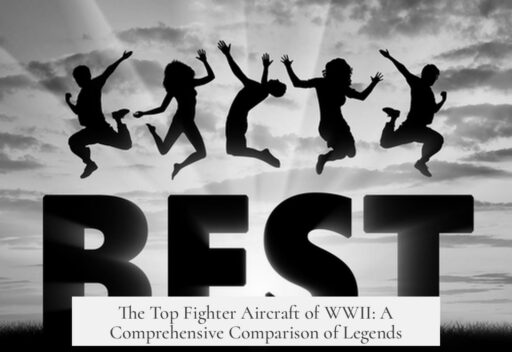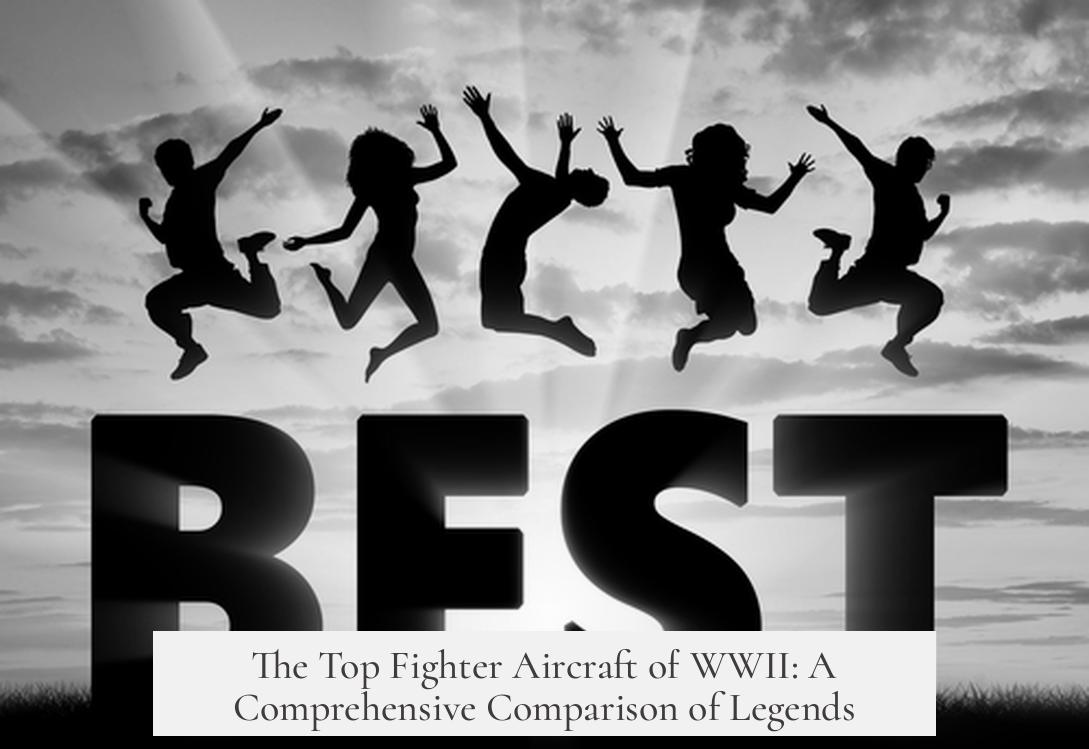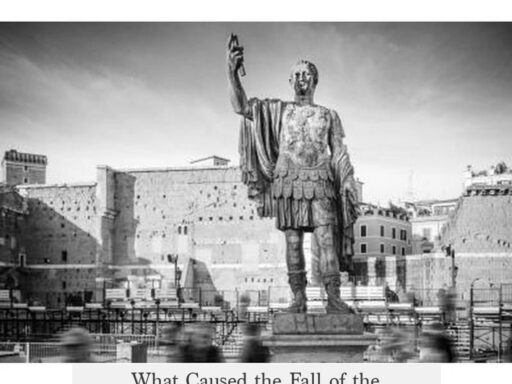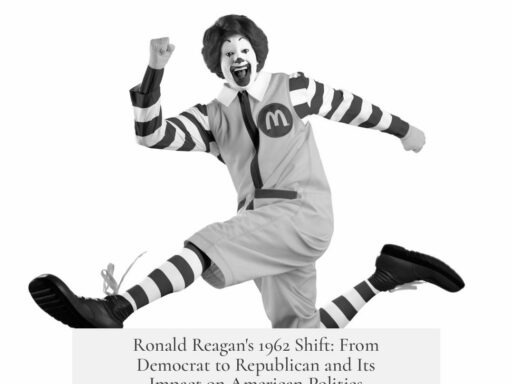The best fighter aircraft of World War II is a complex choice and depends on criteria like role, technology, and theater. The Messerschmitt Bf 109, the North American P-51 Mustang, and the German Me 262 jet fighter often come up as top contenders, each excelling in unique ways.
The Messerschmitt Bf 109 is widely praised for its longevity and impact. Fielded first in the Spanish Civil War in 1937, it served throughout WWII. Almost 34,000 were built. Bf 109 pilots claimed over 15,000 enemy planes. Its adaptability, from early models to late-war variants, made it formidable for nearly the entire conflict. This fighter combined speed, maneuverability, and firepower, enabling legendary aces like Erich Hartmann, who scored the highest kills in history. The Bf 109’s consistent presence and effectiveness grant it a strong claim as the “greatest” in terms of wartime influence.
In the Allied camp, the P-51 Mustang stands out as arguably the best overall fighter. Its early versions struggled with the Allison engine, but fitting the Rolls-Royce Merlin engine transformed it. The Mustang B and D variants had excellent high-altitude performance and could escort bombers deep into enemy territory, thanks to a combat range exceeding 1,000 miles. It flew up to 42,000 feet and reached speeds near 440 mph, with later versions maximizing speed and visibility. The P-51 also offered a balance of firepower, maneuverability, and reliability. It significantly reduced bomber losses over Europe and earned a reputation for dominance against Luftwaffe fighters, excelling particularly in the Western Front.
The Messerschmitt Me 262
Other fighters excelled in specialized roles. The F6F Hellcat dominated naval battles with a 19:1 kill-to-loss ratio. It thrived in carrier operations, credited with downing more enemy aircraft than any other Allied naval fighter. Its rugged design allowed return from serious damage — a testament to durability alongside firepower.
The Republic P-47 Thunderbolt represents versatility. Known as a multi-role fighter, it combined speed, armor, and heavy armament of eight .50 caliber machine guns. Excelling as both an escort and fighter-bomber, it disrupted enemy logistics and air strength. Powered by a large radial engine, the P-47 could dive at high speeds to escape threats and was reliable in harsh conditions.
The de Havilland Mosquito provided an uncommon angle. Made largely of wood, it was initially a fast unarmed bomber but evolved into an efficient night fighter and reconnaissance aircraft. Its lightweight construction granted excellent performance at high altitudes, proving nimble and versatile despite unconventional materials.
The Focke-Wulf Fw 190 earned respect for firepower, speed, and notably quick roll rate. The FW 190’s strength lay in maneuverability characterized by exceptional roll performance, useful in dogfights. Its variants served in roles from day fighters to ground attack, showing design flexibility. Pilots appreciated its robust engine and balanced handling.
The Supermarine Spitfire remains iconic. Its graceful design and good turning circle made it a favorite during the Battle of Britain. While it lost competitive edge to newer fighters late in the war, continuous upgrades kept the Spitfire relevant. It symbolized British air resistance and was effective across multiple theaters.
On the Eastern Front, Soviet fighters like the Yakovlev Yak-3 and Lavochkin La-5 showed competitive maneuverability and firepower. They suffered from quality and production issues, but could rival Western planes in skilled hands.
Considerations when naming the “best” must include mission type, altitude, speed, armament, range, and pilot skill. For instance:
- Versatility favors the P-47 Thunderbolt.
- Speed and innovation point to the Me 262.
- Longevity and kill count favor Bf 109.
- Range and escort capability highlight the P-51 Mustang.
- Durability and carrier-based success emphasize the F6F Hellcat.
Maneuverability can vary between turning radius and roll rate, affecting dogfight outcomes differently. Turn radius benefits planes like the Spitfire, while quicker roll rates favor the FW 190.
Overall, no single aircraft dominated every aspect. The best suited fighter depended on the role, theater, and pilot expertise. Training and tactics mattered immensely—hit-and-run capability or spotting the enemy first often decided battles beyond just aircraft specifications.
Key takeaways:
- Bf 109 excelled in longevity and kill claims over the war’s duration.
- P-51 Mustang offered unmatched range and high-altitude performance for bomber escort missions.
- Me 262 was technologically advanced but limited by late deployment.
- F6F Hellcat dominated naval air combat with durability and kill ratio.
- P-47 Thunderbolt was a versatile multi-role powerhouse.
- Spitfire and FW 190 balanced maneuverability and firepower in dogfights.
- Pilot skill and mission type are crucial in defining best fighter.
The Quest for the Best Fighter Aircraft of WWII: A Sky-High Showdown

So everyone, you’re wondering what the best fighter aircraft of WWII was? Let’s cut straight to the chase: the title often goes to the Messerschmitt Bf 109. It’s tough to argue with a fighter that saw combat from the Spanish Civil War in 1937 to the very last days of World War II, produced nearly 34,000 units, and whose pilots racked up over 15,000 enemy kills.
But hold your bomber runs! The story doesn’t stop there. WWII fighter aircraft are a colorful, complex roster where “best” depends on the mission, altitude, and even pilot skill. Let’s buckle up and tour these legends of the sky.
Why The Bf 109 Soars to the Top
The Messerschmitt Bf 109 is a titan in WWII aviation history. Besides longevity, it dominated aerial combat thanks to its well-rounded capabilities. Pilots like Erich Hartmann, Günther Rall, and Gerhard Barkhorn—top aces scoring hundreds of kills each—were deadly in their Bf 109s. They demonstrate that a fighter’s prowess partly depends on who’s behind the stick.
The plane’s performance evolved to stay competitive through rapid technological advancements. It sported respectable speed, solid climb rates, and enough armament to keep Allied planes on their toes. It wasn’t flawless—some early versions struggled at high altitudes—but its adaptability made it a formidable enemy.
The P-51 Mustang: The American Long-Range Champion
The U.S. answered with the P-51 Mustang, often debated as the “best overall fighter” of WWII. Initially underwhelming as the Mustang Mk I with a less powerful Allison engine, the British’s Merlin engine transfer gave it a turbocharged makeover.
The P-51B and later the P-51D flaunted superb speed, maneuverability, and most importantly, unmatched range—over 1,000 miles. This allowed Mustang pilots to escort bombers deep into Germany, drastically reducing bomber losses. With a ceiling around 42,000 feet and a top speed of about 437 mph (487 mph for the P-51H), it could match or outfly most opponents at any altitude.
It excelled in versatility—serving as a fighter, fighter-bomber, and even night fighter during and after the war. Mustang’s near-perfect blend of speed, armament, and endurance makes it a strong contender for the “best” crown.
Not to Forget: The British Spitfire and the Intimidating Fw 190
Ah, the Spitfire: Britain’s sleek, iconic defender of the skies known for its graceful elliptical wings and nimble aerial ballet moves. It fought all war long, a symbol first of hope and then unstoppable grit.
While its early Spitfire Mk V had superior turning radius to the German Fw 190A, the FW 190 boasted quicker roll rates, thanks to higher wing loading and design that favored instantaneous maneuverability over tight turns. This made the FW 190 fearsome and versatile—effective as a day fighter, fighter-bomber, and ground-attack craft.
Both planes had their advantages, which fueled endless debates. The Spitfire kept Allied morale high, while the FW 190 became a nightmare for Allied pilots when it debuted.
F6F Hellcat and P-47 Thunderbolt: The Durable American Workhorses
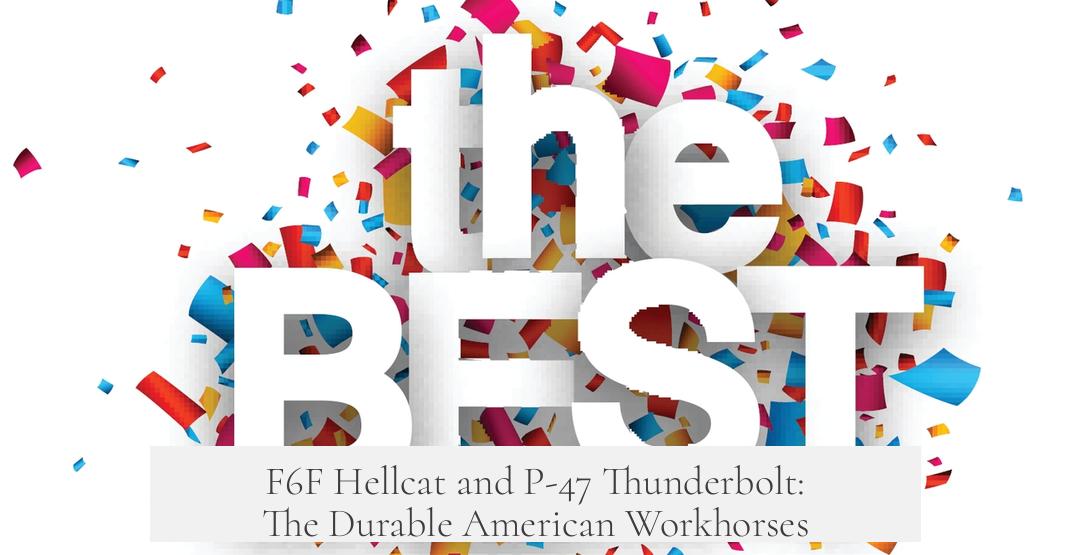
While European fighters grabbed headlines, American aviation produced sturdy giants. The F6F Hellcat was an aircraft carrier specialist with a staggering 19:1 kill-loss ratio. It was rugged, reliable, and easy to repair mid-battle—one pilot reportedly returned to deck with massive wing damage and still asked for more fuel and ammo!
Then there’s the P-47 Thunderbolt, a beast of burden powered by a radially air-cooled engine. At the time, it was the largest and heaviest piston-engine fighter. It was great for multi-role missions—escorting bombers at high altitude, then turning into a fighter-bomber hammering ground targets on the way home.
The P-47’s durability meant it could take hits and still fly, while its eight .50 cal machine guns delivered a bark louder than its bite. It did more missions than the P-38 Lightning and P-51 combined, proving its value as both a guardian and an attacker. Its ability to dive away from danger faster than most was a key survival tactic.
The Unique Case of the de Havilland Mosquito
Not your traditional fighter, the British de Havilland Mosquito is a fascinating player. Made largely of wood, it’s a lightweight speedster that started as a fast, unarmed bomber but evolved into a night fighter and reconnaissance plane. It’s not “fighter” material in classic terms, but its speed and altitude performance made it a deadly niche aircraft.
If daring and resourcefulness count, then this wooden wonder belongs in the discussion.
Breaking the Sound Barrier… Almost: The Me 262 Jet Fighter
Now for the sci-fi twist. As WWII drew to a close, Germany unleashed the Me 262, the world’s first operational jet fighter. It flew circles around piston planes in speed and firepower, boasting twin jet engines capable of around 540 mph—way faster than prop-driven adversaries.
Was it the best? In raw performance and innovation, yes. In impact, no. Its late arrival and mechanical teething issues—plus limited pilot training—dampened its game-changing potential. Still, for a glimpse of the future, this jet fighter was unparalleled.
Debate swirls about including jets versus piston-engine fighters, but the Me 262 is a worthy finalist in any “best fighter” discussion.
Other Noteworthy Contenders: Yak-3, La-5, and More
Soviet designs like the Yak-3 and La-5 gained respect for blending speed, maneuverability, and armament. Their downside? Production problems and quality control sometimes undermined their potential. Yak-3, in particular, had a quick roll rate and was highly favored by pilots—almost the unsung hero of the Eastern front.
And then there’s the quirky Boulton Paul Defiant—an aircraft that tried its best as a turret-armed fighter, boasting some impressive kill claims early on before getting outmaneuvered and scrapped from frontline day combat. It’s a reminder that innovation doesn’t always hit the mark.
The Elusive “Best” — Why Answering This Is Tricky

“Best at what?” is a common retort in this debate. Cost, reliability, versatility, pilot skill, and even production numbers all sway the discussion.
Is a plane the best because it shot down the most enemies? Or because it turned tightest? Or could dive the fastest? Perhaps it carried the most bombs or had phenomenal endurance. The truth is, there is no single answer.
For example, American planes favored heavy armor and high-powered engines, enabling quick dives away from trouble. The Japanese A6M Zero excelled in tight turns and low stall speeds but lacked armor, making it fragile. The Bf 109 had a better climb rate than early-war Hurricane and French M.S.406 fighters, allowing escapes and tactical advantages.
Equally important, pilot skill and situational awareness often determined who came out on top. Training quality was inconsistent. Veteran pilots had instincts honed from hunting experience, spotting opponents in the glare of the sun, and squeezing off shots before being noticed.
Battle of the Metrics: Maneuverability Explained
Maneuverability isn’t a one-size-fits-all trait. There’s:
- Sustained turn radius: tighter turns mean you can circle an opponent, outmaneuvering them.
- Instantaneous turn rate (roll rate): ability to quickly change direction or bank sharply.
The Spitfire Mk V had an edge in turn radius over the FW 190A—great for dogfights and energy conservation. The FW 190’s better roll rate allowed rapid evasion and aggressive rolling attacks. Both approaches had pros and cons depending on the pilot’s style and battle conditions.
Final Thoughts: Picking Your Sky King
So, what’s the best fighter aircraft of WWII? If you want to crown “The Greatest,” the Messerschmitt Bf 109’s legendary service record and ace tally make it a strong candidate. For “The Most Versatile,” the P-47 claim the throne. The P-51 Mustang’s combination of speed, range, and firepower secured air superiority in the West and earns it acclaim as possibly the best “all-rounder.”
Iconic planes like the Spitfire and FW 190 continue to inspire. The F6F Hellcat was king of the carriers, while the Mosquito carved out a unique niche. The Me 262 ushered in a jet age still unfolding today.
Ultimately, your pick depends on the criteria and theater of battle. Are you a cockpit-fan looking for speed and range? Or a dogfight connoisseur admiring nimble turns? Or a history buff wanting to honor technological daring? Whatever your choice, these fighters transformed history and sketched aerial combat’s thrilling landscape.
If You Could Fly One, Which Would You Choose? And Why?
Think about it—the fast, fearsome German ace pilot in a Bf 109 with hundreds of kills? The visionary American Mustang pilot escorting bombers deep over enemy territory? Or maybe the resilient Hellcat pilot braving naval skies? The answer may reveal what qualities you value most: speed, firepower, toughness, or sheer iconic glory.
One thing’s certain: WWII fighter aircraft were marvels of engineering, courage, and innovation. Their stories remain etched in history, their silhouettes still captivating enthusiasts and historians decades later.
